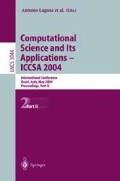Abstract
Long-distance liquid transport in biosystems is provided by special branching systems of tubes (arteries, veins, plant vessels). Geometry of the systems possesses similar patterns and can be investigated by computer methods of pattern recognition. Here some results on plant leaf venation investigation are presented. The lengths, diameters and branching angles are estimated for the leaves of different shape, size and venation type. The statistical distributions of the measured parameters are similar to the corresponding ones which have been obtained for arterial beds. The both correspond to the model of optimal branching pipeline which provide liquid delivering at minimum total energy consumptions. The biomechanical model of liquid motion in a system consisting of a long thin tube with permeable walls which is embedded into a biological porous medium is considered. The pressure distributions and velocity fields for different geometry of the system are obtained. The main result is when the delivering liquid is completely absorbed by the alive cells in the porous medium the relation between the diameter and the length of the tube and the total volume of the medium which correspond to the measured data is reached.
Access this chapter
Tax calculation will be finalised at checkout
Purchases are for personal use only
Preview
Unable to display preview. Download preview PDF.
References
La Barbera, M.: Principles of Design of Fluid Transport Systems in Zoology. Science 249, 992–1000 (1990)
Pries, A.R., Secomb, T.W., Gaehtgens, P.: Design Principles of Vascular Beds. Circulat. Res. 77, 1017–1023 (1995)
Zamir, M., Bigelov, D.C.: Cost of Departure from Optimality in Arterial Branching. J. Theor. Biol. 109, 401–409 (1984)
Zamir, M.: Branching characteristics of human coronary arteries. Can. J. Physiol. 64, 661–668 (1986)
Kitaoka, H., Suki, B.: Branching Design of the Bronchial Tree Based on a Diameter-Flow Relationship. J. Appl. Physiol. 82, 968–976 (1997)
Kitaoka, H., Takak,i R., Suki, B.: A Three-Dimensional Model of the Human Airway Tree. J. Appl. Physiol. 87, 2207–2217 (1999)
Kizilova, N.N.: Transport System and Growth of Leaves. In: Belousov, L., Stein, A. (eds.) Mechanics of Growth and Morphogenesis, pp. 379–405. Moscow Univ. Press, Moscow (2001)
Kizilova, N.N.: Construction Principles and Control over Transport Systems Organization in Biological Tissues. In: Fradkov, A.L., Churilov, A.N. (eds.) Physics and Control, St. Petersburg, vol. 1, pp. 303–308 (2003)
McCulloh, K.A., Sperry, J.S., Adler, F.R.: Water Transport in Plants Obeys Murray’s Law. Nature 421, 939–942 (2003)
Honda, H.: Tree branch angle: maximizing effective leaf area. Science 199, 888–889 (1978)
Zhi, W., Zhao, Ming, Yu: Qi-Xing: Modeling of Branching Structures of Plants. J. Theor. Biol. 209, 383–394 (2001)
Rosen, R.: Optimality Principles in Biology. Plenum Press, New York (1967)
Dawson, C.A., Krenz, G.S., Karau, K.L., et al.: Structure-Function Relationships in the Pulmonary Arterial Tree. J. Appl. Physiol. 86, 569–583 (1999)
Pelletier, J.D., Turcotte, D.L.: Shapes of River Networks and Leaves: are they Statistically Similar? Phil. Trans. Royal Soc. London, Ser. B 355, 307–311 (1999)
Henton, S.M., Greaves, A.J., Piller, G.J., Minchin, P.E.H.: Revisiting the Münch Pressure- Flow Hypothesis for Long-Distance Transport of Carbonhydrates: Modeling the Dynamics of Solute Transport Inside a Semipermeable Tube. J. Experim. Bot. 53, 1411–1419 (2002)
Kizilova, N.N.: Hydraulic Properties of Branching Pipelines with Permeable Walls. Appl. Hydromech. 38, 78–84 (2003)
Author information
Authors and Affiliations
Editor information
Editors and Affiliations
Rights and permissions
Copyright information
© 2004 Springer-Verlag Berlin Heidelberg
About this paper
Cite this paper
Kizilova, N. (2004). Computational Approach to Optimal Transport Network Construction in Biomechanics. In: Laganá, A., Gavrilova, M.L., Kumar, V., Mun, Y., Tan, C.J.K., Gervasi, O. (eds) Computational Science and Its Applications – ICCSA 2004. ICCSA 2004. Lecture Notes in Computer Science, vol 3044. Springer, Berlin, Heidelberg. https://doi.org/10.1007/978-3-540-24709-8_51
Download citation
DOI: https://doi.org/10.1007/978-3-540-24709-8_51
Publisher Name: Springer, Berlin, Heidelberg
Print ISBN: 978-3-540-22056-5
Online ISBN: 978-3-540-24709-8
eBook Packages: Springer Book Archive

